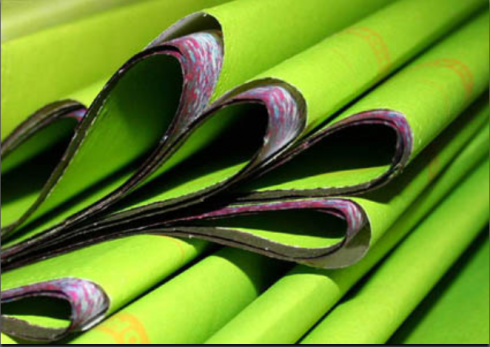
Mountain Green by Deborah Beaumont
This digital print is a photograph of a pile of green spoils.
85 x 110cm
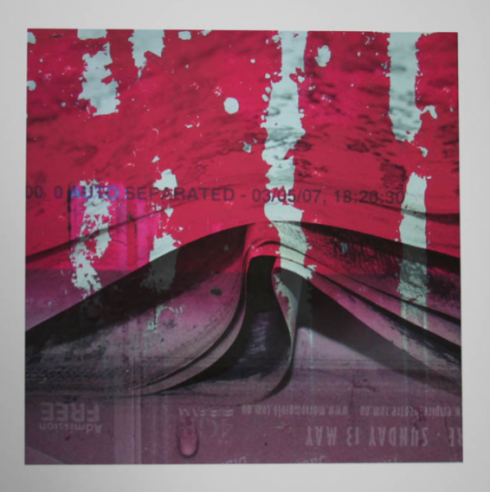
Confusing Days by Deborah Beaumont
In her own words: This digital print comprises of two layers of images. The first layer is a detail of
the edges of spoils, and the second, is a photograph of the edge of a magenta
printing plate.
At the exhibit: those abandoned pages on the floor of the printing plant become works of art
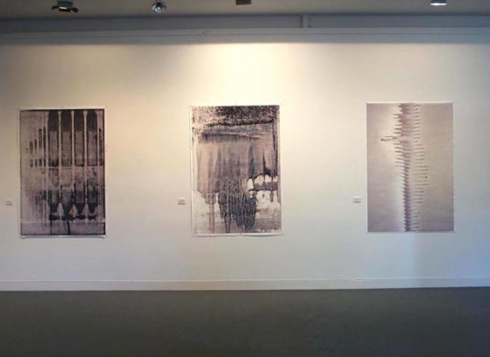
2005 Power Grid exhibition
These three images are digital prints. They are photographs of spoils and the
centre print has been overpainted using authentic newspaper ink (Regal Knife
Black). Each print is 180 x 120 cm (6 x 4ft).
Plate—-who would have dreamed that the pages that we all step on could become such visual surprises?
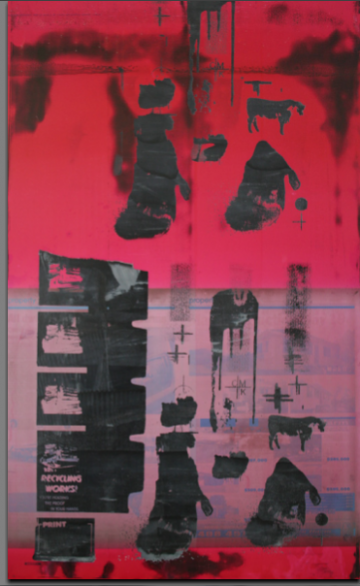
Plate 44
The artist explains her work:
This is a magenta printing plate that I have printed on top of. The images that
I have added are taken from transparencies that were once used in creating a
printing plate. They are photographic film that was placed on a light-sensitive
printing plate. Our new press now uses computer to plate technology – so the
transparencies are a technology of days past.
Deborah and the tools of her artistic inspiration
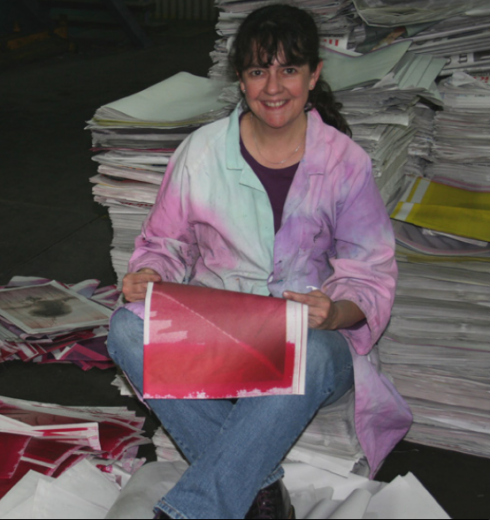
In her own words: Here I am looking very pleased that my spoilspaper project has become a
reality. I am sitting among the spoils that were created during the print-run.
I first came in contact with Deborah when she wrote me to see if I could get her in touch with people at The Wall Street Journal in New York City. It was one of her aims to visit the Journal’s printing plant and to collect spoilage from the world’s most famous financial daily. She did, and now we can say that the Journal, among other accolades and distinctions, can be proud to be part of Deborah’s artistic portfolio. Lists of stocks and financial information transformed into art for the ages.
Here is how Deborah describes what she does, and how she got inspired to use those ink-saturated or wrinkled pages that are thrown out daily, by the hundreds, by newspapers around the globe:
I felt that pulping them would have been tragic. I collected a bundle of them to take home and began to collage with them. Before I realized it, these spoils and other
print detritus from my local newspaper, had become the entire focus of my visual arts practice, and they were made into a range of artforms including artist’s books, large
scale digital prints, and prints on the used printing plates. Some of my works are owned by state libraries and galleries.
Deborah’s art practice and now PhD research, center on this process of translating
incidental and accidental prints into a new print form.
I recognise the spoils and used newspaper printing plates as artefacts of local popular culture – they contain within
them the history of production and the stories of people and places. My house is now something akin to a museum of superseded and current newspaper print technology.
Racks of used newspaper printing plates align my studio walls, and set after set of mapping draws are full of newspaper spoils as well as the old transparencies once
used when photographic film was used to prepare the photo-polymer lithographic printing plates.
Recent changes in local newspaper printing processes have provided Deborah with the
opportunity to explore the use of two different newspaper printing presses to make
my artworks. She works closely with APN Print (Qld, Australia),
to develop a tabloid-format artwork known as a spoilspaper. The spoilspaper is a
collection of images collected from the newspaper print-production site and this
includes the spoils as well as images of the site itself.
These images have then been (re)printed on the newspaper printing press that created the original spoils. The first
of the two spoilspapers was printed on a Harris 845 newspaper press (its last run after 30 years of production) and it therefore marks a historic moment in local
newspaper production as well as being a unique print artform. A second spoilspaper has recently been printed on a Manugraph Cityline Express.
For those interested in more information about Deborah Beaumont:
The following site has examples of Deborah’s work –
http://www.saatchi-gallery.co.uk/stuart/StudentArt/ast_id/85124
Deborah’s email address – dbeaumon@tpg.com.au or
d9180336@mail.connect.usq.edu.au
![]()
Of special interest, and related to our posting of yesterday:
https://www.garciamedia.com/blog/articles/never_on_monday—-or_tuesday_or_wednesday_how_newspapers_redefine_daily/
Now three Philadelphia-area newspapers announce that they will drop Saturday editions:
– USA: 3 Philly-Area Dailies Will Drop Saturday Paper
http://www.editorandpublisher.com/eandp/news/article_display.jsp?vnu_content_id=1003936787

To read TheRodrigoFino blog, in Spanish, go:
https://garciamedia.com/latinamerica/blog/
Today Rodrigo Fino writes about how the economic crisis affects free newspapers; also—how some US newspapers making thru linking advertising sales with Yahoo. In addition, he takes us back to 1981 and a video where someone was forecasting “new” ways of reading newspapers in the future. The future could be now.
Duration: 02:17
[+] See the video: youtube.com
TheMarioBlog posting #184